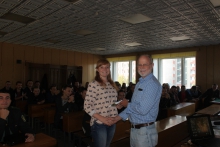
On September 25 and 27, Mr. Ted Geier, Regional Hydrologist for the Eastern Region of the US Department of Agriculture, co-authored the USFS Watershed Condition Classification Technical Guide, delivered lectures entitled “Introduction to the Watershed Condition Framework (WCF). The 6-Step Adaptive Management Process” for students of Uzhhorod State University and the National Forest Technical University of Ukraine in Lviv.
Lectures were organized in the framework of the project "Skilled Foresters = Better Forests," implemented by the NGO Agency for Sustainable Development of the Carpathian Region "FORZA" with financial support of the US Forest Service International Programs.
Ted Geier’s lecture started with the history of forest harvesting in the United States in the 18th and 19th centuries, followed by highlighting the impact of timber harvesting and transportation on the environment (deforestation, loss of productivity of forests), especially soil and water (formation of gullies, landslides and mud processes, devastating floods, silting, destroying banks and riverbed degradation and loss of habitats, extinction of fish and other aquatic organisms). The negative effects of logging prompted government officials and legislators to enact legislation that widened the mission and role of the US Forest Service towards improvement and protection of forests, ensuring continuity of timber supply and forest productivity along with other functions of forests, by sustainable management of wildlife and fish resources, watersheds, rangelands and recreation.
The main focus of Ted Geier’s lectures was the importance of the interrelations among various elements within the watershed and, therefore, the importance for forestry practitioners to understand how interventions in one part of the watershed can affect other elements within the whole area of the watershed. The USFS uses a tool called Watershed Condition Framework (WCF) to help assist them in the proper management of watersheds. WCF is used to analyze and make decisions related to improvement and restoration of the state of the watershed. WCF is based on 6-step adaptive management cycle, with the first step (A) which is to classify the watershed conditions. In order to take this step, there is an assessment, which includes 4-groups and 12-indicators and takes into account the condition of the aquatic physical processes; aquatic biological processes; terrestrial physical processes; terrestrial biological processes; and is assessed by set of indicators and attributes. When a watershed is assessed, it receives one of the three classes of watershed condition: 1 – Properly Functioning (green color); 2 – Functioning at Risk (yellow); or 3 – Impaired Functioning (red).
The next steps of the WCF cycle are:
(B) Identification of Priority Watersheds (which is based on the set of rules, not only by the watershed condition class or color, followed by:
(C) Development of Watershed Action Plans (which are project-based and aim to improve the watershed condition and to determine the respective class and address certain environmental issues/ problems in the area);
(D) Implementation of Watershed Action Plans (which are aimed at proper and timely implementation of all projects);
(E) Tracking of Restoration Accomplishments (which includes free access to an on-line map with information about implemented projects in priority watersheds);
(F) Monitoring and Verification (focused on two levels including (1) checking to see that everything which was planned was implemented; and (2) finding out if the projects/ actions were effective and led to the expected results.
It is important to understand that the monitoring and verification step is not designed to place blame or guilt on the forester or forest, but rather to find out how to improve the work in the future using the WCF adaptive management cycle.
At the end of the lectures, Ted Geier noted the most active students who asked questions related to the topic and handed them publications on issues of forest management and the hydrological role of forests.
Photo report from lecture in Uzhhorod: https://photos.app.goo.gl/Ryx3LSVosceXDeb82
Photo report from lecture in Lviv: https://photos.app.goo.gl/hYz1hTBoiDTEolaD3




